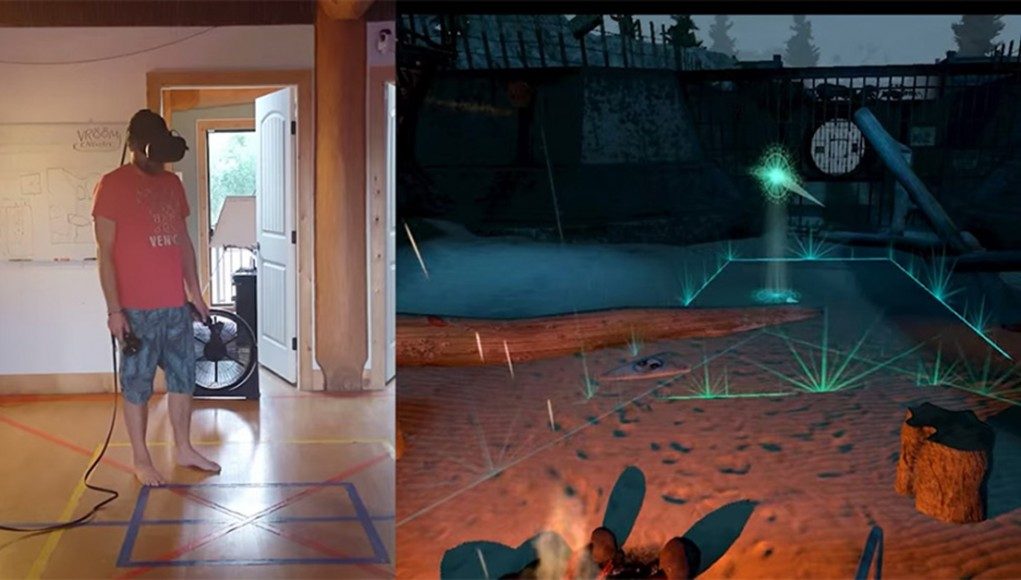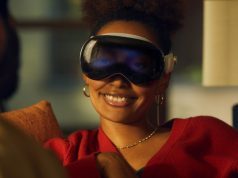 One of the challenges with a first-person VR adventure game is that locomotion causes some people motion sickness. People have a wide range of tolerances for how much they can move around a VR space with a controller, and room-scale VR helps to eliminate nausea because your real movements match your virtual movements 1:1 and there’s no disconnect within your vestibular system. However, there’s still the problem of how to move within a virtual space that’s larger than your limited room-scale VR physical space. Cloudhead Games has come up with a really elegant solution in their The Gallery experience for projecting your room-scale volume within your virtual space in a system they call “Blink,” and it does really lives up to the promise of 100% nausea-free VR locomotion.
One of the challenges with a first-person VR adventure game is that locomotion causes some people motion sickness. People have a wide range of tolerances for how much they can move around a VR space with a controller, and room-scale VR helps to eliminate nausea because your real movements match your virtual movements 1:1 and there’s no disconnect within your vestibular system. However, there’s still the problem of how to move within a virtual space that’s larger than your limited room-scale VR physical space. Cloudhead Games has come up with a really elegant solution in their The Gallery experience for projecting your room-scale volume within your virtual space in a system they call “Blink,” and it does really lives up to the promise of 100% nausea-free VR locomotion.
Cloudhead Games has been working on their first-person VR adventure game The Gallery for over two years now, and they’ve been one of the leading innovators in solving this VR locomotion motion sickness issue. They came up with the VR comfort mode approach of incrementing in 10-15 degree increments when doing raw rotation with the joystick.
Cloudhead Games was showing off their latest Blink VR locomotion system at PAX this past weekend, and I had an opportunity to try it out. I’m someone who is very sensitive to motion sickness to the point where I can’t really even move around with a controller within a VR environment for more than 5-10 minutes without starting to feel some motion sickness. I was able to do a 15-20 minute demo of the first episode of The Gallery called “The Call of the Starseed,” and I wasn’t feeling any type of motion sickness symptoms.
I talked with Cloudhead Games producer Joel Green about their Blink new system, and some of his insights after using it for a couple of months. Joel says that there’s going to be a new skill that people need to develop within room-scale VR, which is to be able to have a dual awareness of where they’re located within their physical space as well as where they’re located within VR. He says that it takes some practice to learn this skill, but that after people can have this dual spatial awareness that they’re able to move much more quickly and confidently within a VR space.
I feel like I’m still relatively new at this skill, and so I found myself moving very slowly within the experience and was bumping up against the chaperone boundary system within the experience more often than I should have had I been more aware of where I was located within the physical space. Joel said that they decided to place a visual representation of the boundaries of your physical space within the experience to help people make this connection because they did find that people would blink teleport to a new spot and not really feel comfortable to walk around their room-scale volume if they didn’t have that spatial awareness and confidence.
There’s a system of volumetric blinking where you visualize and rotate your room-scale volume and place it more precisely around objects within an area that you’d like to explore. I found this to be really helpful because it did start to give me a better idea as to whether or not I’d be able to interact with those objects without worrying about if they were outside of the volume or not.
One other innovation that was interesting is that they were using a backpack as their inventory system. You have to reach over your shoulder and pull the trigger in order to take off your backpack and place it in front of you. It was something that felt natural and intuitive, and felt like another elegant solution to a tricky problem. It felt like a really good tradeoff for how to present a 3D representation of an adventure game inventory that preserves the realistic nature of VR, but yet also has an intuitive user interface that is efficient to use.
One challenge in an adventure game like this is figuring out which objects are valuable to solving puzzles, and which ones are just simply fun to play with but won’t ultimately help you advance through the game. Part of the logic that was implemented within The Gallery was a backpack inventory system where if an object was important enough to be used later, then you can put it in your backpack and it’ll automatically be stored there again if you drop it. If it’s not important, then it’ll just drop to the ground. This would allow you to pick up objects from one room, and then use them in another room.
Joel helped guide me through the many different puzzles within the experience, and I think that there’s going to be a lot of really exciting exploration, puzzles, and fun gameplay within The Gallery experience. They have a solid foundation with a VR locomotion system that is indeed 100% nausea-free, and so now they can focus on finishing up the content with engaging puzzles in time for the consumer Vive launch.
Audio PlayerBecome a Patron! Support The Voices of VR Podcast Patreon
Theme music: “Fatality” by Tigoolio










